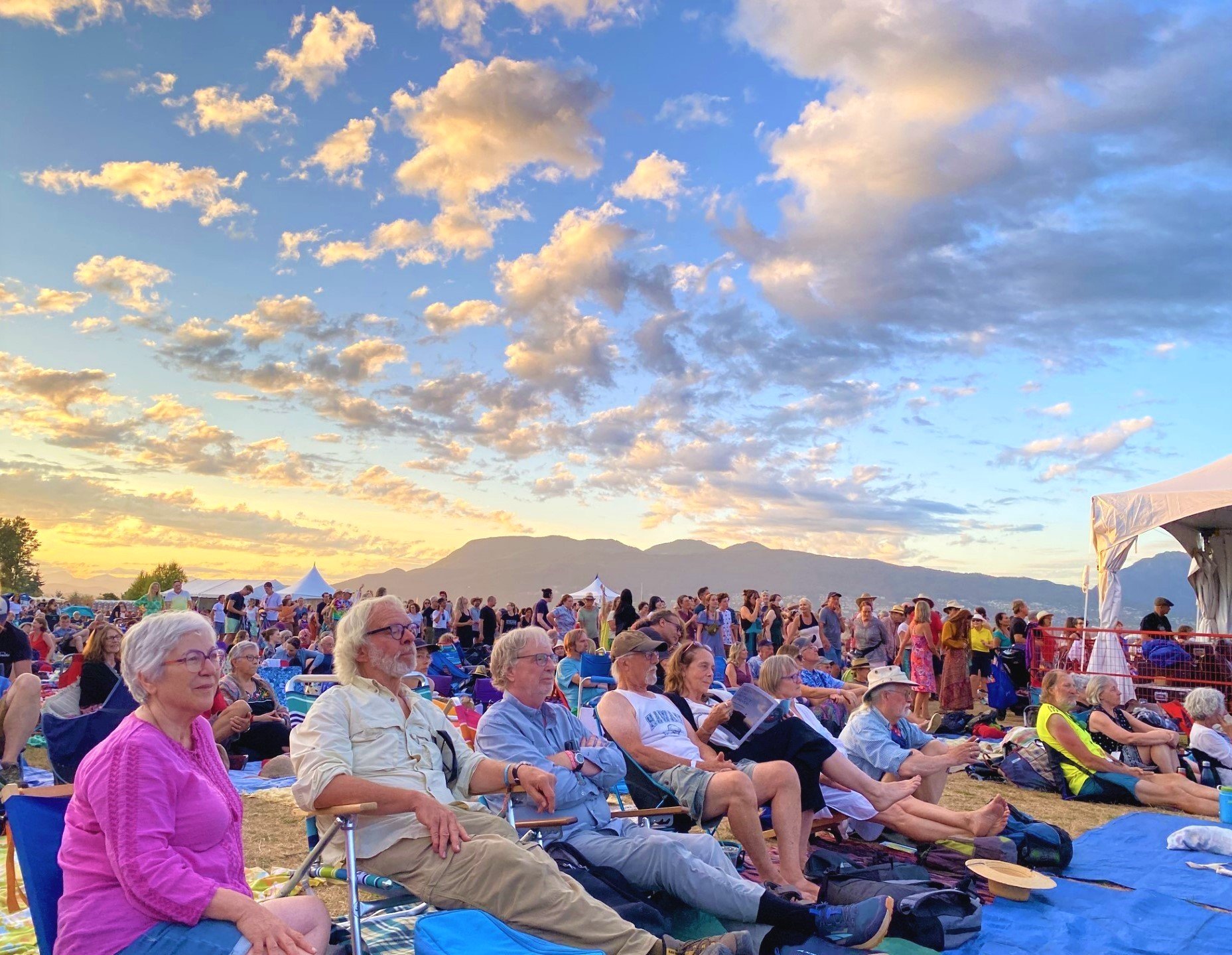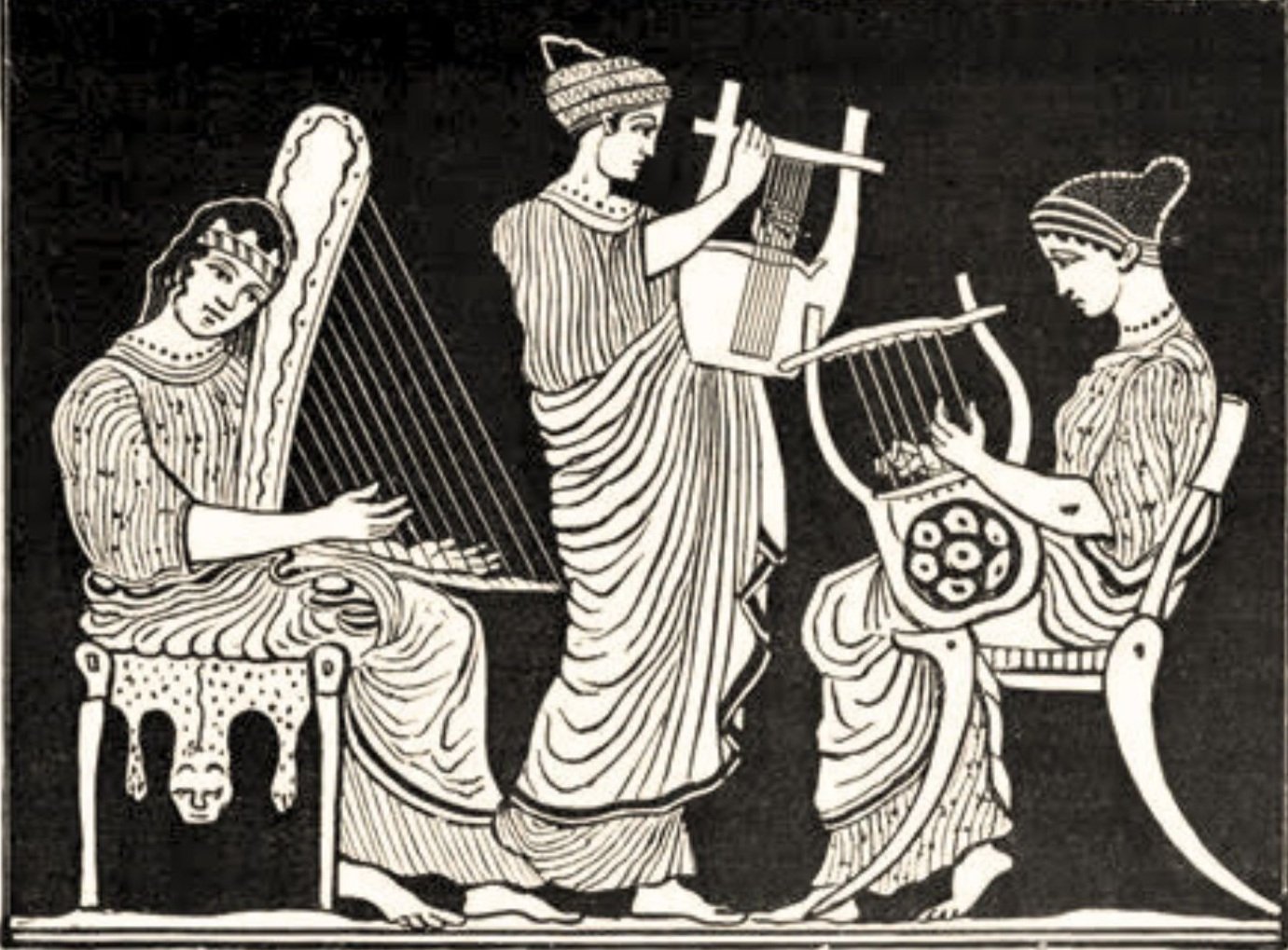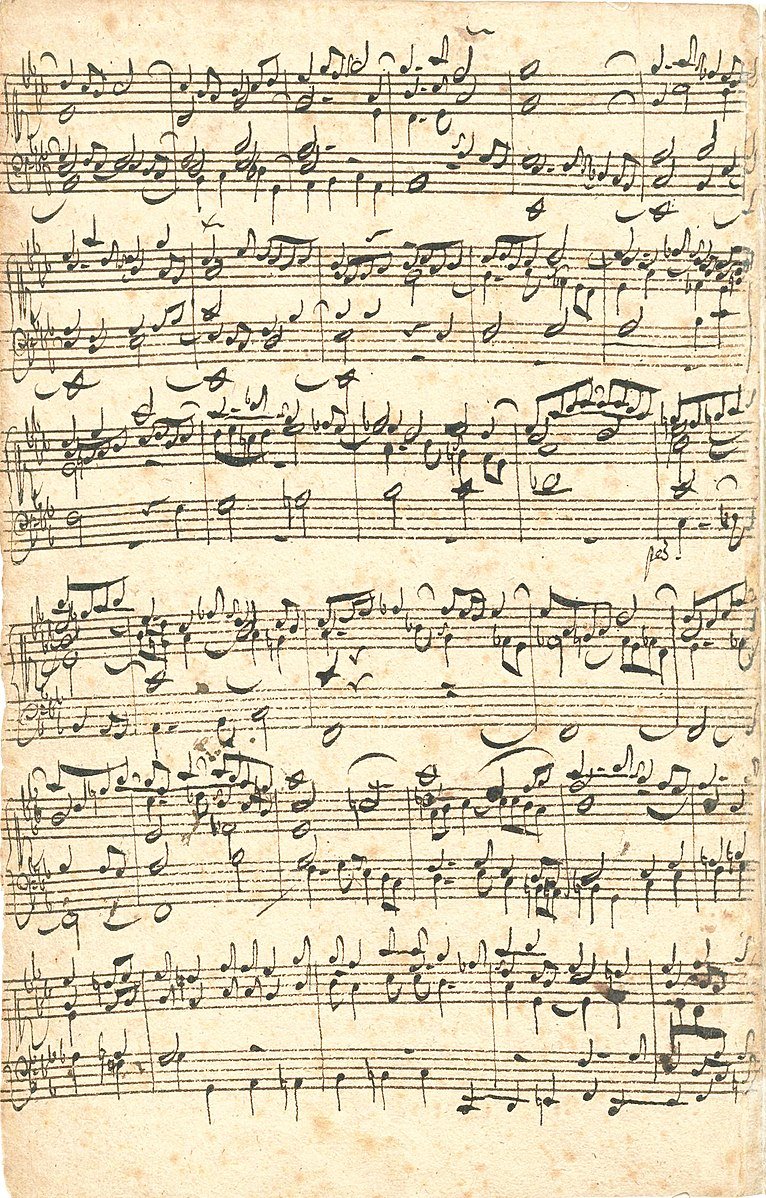A chapter-by-chapter series of images illustrating key ideas in my book Wired for Music. Click here to view the series from the start.
Chapter 3: Groove, Interrupted [excerpts]
At a beachside festival in Vancouver, I wandered through the crowds for hours…
A recent scene from the Vancouver Folk Music Festival, the seaside event that introduced me to the band Cascabulho and led to a trip to Recife, Brazil. Photo Adriana Barton, all rights reserved.
I was thirty, still reeling from another blown-up relationship and moldering as a tourism-magazine editor when what I really wanted was to write.
Just as I was heading for the festival exit, I heard music with a bounce to it — a catchy, hyperactive quality that drew me back in.
The band, Cascabulho, mashed together drums and electric bass with folk songs from Brazil’s Northeast.
I followed them to Brazil. Not for a fling or a stint as a groupie, but with a hope that some of their buoyant energy might rub off.
Original members of Cascabulho, the band that inspired me to check out the music scene in Recife, Brazil. Photo Adriana Barton, all rights reserved.
The ragged metropolis of Recife took me aback.
Beyond the compact colonial district, settled in the 1530s by the Portuguese, the city of more than three million was chockablock with crumbling apartment buildings and hand-built favelas.
A favela at the water’s edge in Recife, Brazil. Photo Elvis Boaventura, Creative Commons.
But wherever I went in Recife, people sang one minute and drummed the next, dancing all the while.
I envied how easy they made it look.
A trio of young women showed me their chops on a two-sided drum called the alfaia, played with thin mallets that made a heavy booming sound. Photo Adriana Barton, all rights reserved.
In Brazil, no one batted an eye if someone played a smidgen before the beat or sang a little off-key. It was all part of the musical texture.
But where I come from, countless people don’t dare sing except in the shower. Others swear they couldn’t carry a beat to save their life.
The deficits we call “tone deafness” or “left-footedness” are largely cultural.
A 1931 report from the magazine Popular Science describes tests designed to separate “musical” children from the supposedly “tone deaf.” Photo U.S. public domain.
The more I learned about our species’ innate musicality, the more my culture’s approach to music struck me as bizarre.
I dusted off my history books, determined to pinpoint the source of these hang-ups.
A Muse with a harp and two others with lyres. Image from a Greek vase in the Munich Museum. Photo public domain.
The ancient Greeks believed everyone could and should have a knack for music, most often blended with poetry and dance.
Writing on fragile papyrus scrolls, they described music as a source of divine wisdom from the Muses, the nine goddesses of literature, science, and the arts.
But playing an instrument wasn’t just for a-Muse-ment.
The nine Muses of Greek mythology, painted by Venetian artist Jacopo Tintoretto (1518-1594). Image in U.S. public domain.
In the sixth century BCE, Pythagoras convinced his followers that planetary bodies moved according to the same mathematical ratios found in musical scales.
For the Greeks, music mind-body medicine.
Partway through the Roman Empire, however, music was in for a massive upheaval.
Pagan Rome was a rollicking place. Bacchic rites beckoned worshippers to drink wine and let loose to the “howlings” of drums until they entered a state of ekstasis (Greek for being outside one’s self).
In pagan Rome, horn players pumped up the volume in chariot races, carnival trains, gladiator fights. Bas relief from ancient Rome at Museo nazionale d'Abruzzo. Photo Sailko, Creative Commons.
The Church Fathers realized that to triumph over paganism, the new religion would need to sever all ties to dirty dancing.
‘The devious spells of syncopated tunes,’ wrote Clement of Alexandria, in 195 CE, ‘corrupt morals by their sensual and affected style, and insidiously inflame the passions.’
This mindset would eventually give rise to the most austere music I’ve ever heard: Gregorian chant.
Gregorian singing in the Netherlands. Photo Helena, Creative Commons.
Sung in unison — all the same note — Gregorian chant moves mostly stepwise in small leaps, using only the notes you’d find on the white keys of a piano.
In this solemn chanting of the Latin liturgy, many listeners find transcendent beauty. Even so, this is music stripped to the bone — no harmony, musical instruments, or distinct beat.
Gregorian chant became the official music of the Roman Catholic Church for more than a thousand years. Note the mostly stepwise progression of the melody, and absence of rhythmic notation and harmony. Photo Wasily, public domain.
We take for granted the musical chords we hear in pop tunes. Nevertheless, the entire harmonic system of Western European music developed through the Church, step by step.
Church composers avoided dissonant sounds, especially the Devil’s tritone.
The Devil’s trident inspired the musical term “tritone.” Photo Charles Rodstrom, Creative Commons.
The tritone — the combination of three whole tones — was considered so jarring and difficult to lead into a pleasing harmony that medieval monks were taught not to use it.
As the musicologist John Deathridge explained in an interview with the BBC: “You can read into that a theological ban in the guise of a technical ban.”
In university, I studied counterpoint, the system of relationships between harmonies and musical voices later used by Vivaldi and Bach.
Writing even a short piece of counterpoint was like playing chess, because each era had different restrictions on how one note could move to the next.
In the sixteenth century, for example, the Church’s Council of Trent warned that harmonies “must not give empty pleasure to the ear” and ordered priests to ‘banish from church’ all sounds “that are luscious or impure.”
By the year 2020, classical music accounted for just 1 percent of all music consumed in the U.S.
Yet this antiquated genre clings to its pedestal.
For many of us, the rules embedded in this system continue to shape how we learn to play instruments and think about music — even if we never listen to Beethoven or Bach.
Painting from my mother Susan Feindel’s “Intensive Care” series documenting my brother’s open-heart surgery at the age of 5. The experimental procedure he received in England had never been done in North America. Artwork by Susan Feindel, cover of the Canadian Medical Association Journal in January 1985. All rights reserved.
A year after I began cello lessons, my little brother was born with congenital heart abnormalities that left him battling pneumonia and the constant risk of heart failure.
While my parents drove my brother back and forth to the hospital, the conservatory kept me and my sister busy.
Practicing for our performance exams and orchestra rehearsals was demanding enough, so we never bothered learning extra parts to play in the living room together “just for fun.”
Our family didn’t have a pop-music tradition either, other than the scratched-up Beatles records my British stepfather often played.
The Beatles’ Sgt. Pepper's 50th anniversary billboard in London, England. As a small child, I loved leafing through the pages of this weird and wonderful album. Photo Kreepin Deth, Creative Commons.
I loved “Sgt. Pepper’s Lonely Hearts Club Band” and could sing every word of “Lucy in the Sky With Diamonds” by heart. But the thought of teaching myself the cello part from “Eleanor Rigby” never crossed my mind.
Now I understand why. My sister and I didn’t play our instruments. We worked them.
Outside the Conservatoire de Paris, the (all-male) class of composer Charles-Wilfrid de Bériot in 1894-1895. From left: Maurice Ravel, Camille Decreus, Gaston Lévy, Edouard Bernard, Fernand Lemaire, Charles de Bériot (seated at the piano), Henri Schidenhelm, Jules Robichon, Joachim Malats (seated at the piano), Marcel Chadeigne, Ricardo Viñes, Cortes, André Salomon, Ferdinand Motte-Lacroix. Photo Eugène Pirou (1841–1909), Bibliothèque nationale de France, public domain in U.S. and France.
My first cello teacher had studied at the illustrious Paris Conservatory, founded in 1795. My early music-theory teacher studied there, too, under the tutelage of the great French composer Olivier Messiaen.
No wonder their standards were so high.
The word “conservatory” comes from the orphanages of Renaissance Italy, where foundlings known as conservati (the saved) were initiated from an early age into the life of professional musicians-in-training.
In 1535, the original conservatorio opened its doors, in Naples.
Treble clefs mark the locations of Europe’s first four music conservatories (from left): Conservatorio della Pietà dei Turchini, built in 1583 (still standing), Conservatorio dei Poveri di Gesù Cristo, founded in 1589 (still standing), Conservatorio di Sant'Onofrio a Capuana, built in 1578 (still standing) and the oldest — Conservatorio di Santa Maria di Loreto, built in 1535 (demolished). Map adapted from Wikimedia.
Church entrance in the structure that once housed the Conservatorio di Sant'Onofrio a Porta Capuana at 36 Piazza Enrico de Nicola in Naples, Italy.
One of Europe’s four original music conservatories, it was founded in 1578 as a charitable institution for orphans, or conservati (“the saved”).
The adjacent church is also known as the Chiesa di Sant'Onofrio alla Vicaria.
Photo Baku, Creative Commons.
Inspired by the style of music instruction in Italian orphanages, the state-run Parisian conservatory set the tone for the great conservatories of Europe and, later, North America.
This model remains the foundation of Western music education to this day.
Parents love sharing videos of their child in a piano recital performing ‘Für Elise,’ but back at home, they’re boogying in the kitchen to hiphop or cranking up Arcade Fire.
The sports equivalent would be to send a child to fencing lessons…
…while everyone else watches the hockey game.
Ice hockey fist bump GIF by NHL via Giphy.
From the very first music lessons, children are expected to learn the smallest units of music: notes, beats, rests.
Ethan Hein, a music-education specialist at New York University, believes this approach starts at the wrong level of abstraction.
Taken out of context, notes and rests don’t register as music.
Around the world, plenty of musicians play beautifully without ever learning the Western music notation taught to kids from day one. Symbols from left: treble clef, 4/4 time signature, a whole note, bar line, half note, half note on a ledger line, bar line, 2/4 time signature, quarter note, eighth note, two sixteenth notes, double bar line. Image public domain.
Standard music education tends to focus on an extremely narrow type of music, said Hein.
Namely, “the aesthetic preferences of Western European aristocrats of the eighteenth and nineteenth centuries.”
In the video above, American composer Adam Neely exposes the inherent racial bias in Western music theory as it is typically taught.
The system that gave us musical absolutes, such as metronome rhythm and ‘perfect pitch,’ is presented as the best and most universally valid.
But, in truth, this music reflects the sensibilities of light-skinned people from a certain time and place.
Hein believes classical music could become more relevant in today’s multicultural classrooms if teachers approached it the way sampling producers do, “as raw material for new expression.”
In a national survey of U.S. high schools, just a quarter of graduating students had enrolled in a single music course during any of their four years in high school.
I thought of Billie Eilish, the California teen whose 2019 hit “Bad Guy” topped the charts.
Although the media painted her as a natural-born talent, Eilish started singing in the Los Angeles Children’s Chorus at the age of eight. Hardly an overnight wonder.
Billie Eilish at the 2019 Pukkelpop Music Festival. Photo Lars Crommelinck, Creative Commons.
Her story made me wonder where future Eilishes will come from.
Today’s kids are more likely to log hours on an iPad than a piano keyboard or electric guitar.
But if music teachers fail to offer them what they want and need from music, said Hein, “should we blame the kids for voting with their feet?”
Live music has morphed too. At most concert venues, you can hardly see the stage through all the smartphones snapping away.
Ever been stuck at a concert behind someone whose smartphone is blocking the show? Photo Pxfuel.
In growing swaths around the world, music has become a product created by specialists and marketed to the rest of us.
Capacities for singing and dancing, evolved over millennia, are getting rusty from lack of use.
Mine got rusty, too.
Cover of The Artist’s Way by Julia Cameron. In this insightful book on creativity, first published in 1992, Cameron coined the term “shadow artist” to describe blocked creatives. Image Wikimedia Commons.
In her book The Artist’s Way, Julia Cameron describes the plight of the “shadow” artist, writer, or musician who lives vicariously through others.
As Cameron points out, shadow artists can get nasty towards those with the guts to put themselves out there.
In my mind, this shadow phenomenon helps explain the enormous appetite for TV talent shows that build performers up, only to tear them down.
Fans of American Idol will abandon their vocal champions at the first off-note and then revel in the carnage.
When Simon Cowell, the infamous TV talent judge, smites a quivering contestant with a line like “You’ve just invented a new form of torture,” ratings go up.
The cruelty is part of the point.
Photo Alison Martin, Creative Commons.
In the blood sport of singing, Western societies delight in separating the gifted from the “talentless” masses.
No wonder people shy away from making music.
In my post-cello years, live concerts put me in touch with the physicality of music, if only at arm’s length.
Clockwise from top left: I caught shows by artists including Franz Ferdinand (photo livepict.com), Red Hot Chili Peppers (photo Warner Bros), The Pixies (photo Stefan Svik) and Ben Harper (photo Victor Diaz Lamich).
By my early thirties, I had become a shadow musician.
Listening instead of playing, watching others instead of picking up an instrument myself. Doing my best to convince myself that maybe just listening could be enough.
Click here to view the next chapter of Wired for Music: The Visual Companion. Sign up to receive an email alert for each post.
To order the book Wired for Music, see links on this page.
Sources for all information in this post can be found in the endnotes of the hardcover and paperback editions.
Copyright note: The author is the copyright holder of all text but not all images included in this post. Every effort has been made to identify and indicate the copyright status of each image pictured. In some cases, copyrighted material has been included for the purposes of teaching and scholarship in accordance with “fair use” regulations in Section 107 of U.S. Copyright Law.
Please contact me with any questions, permissions requests, or concerns about copyright.
Disclaimer: Discussions about health topics provided in this post, or in any linked materials, are not intended and should not be construed as medical advice, nor is the information a substitute for professional medical expertise or treatment. The author accepts no responsibility or liability for any health consequences relating to information published on this website.































